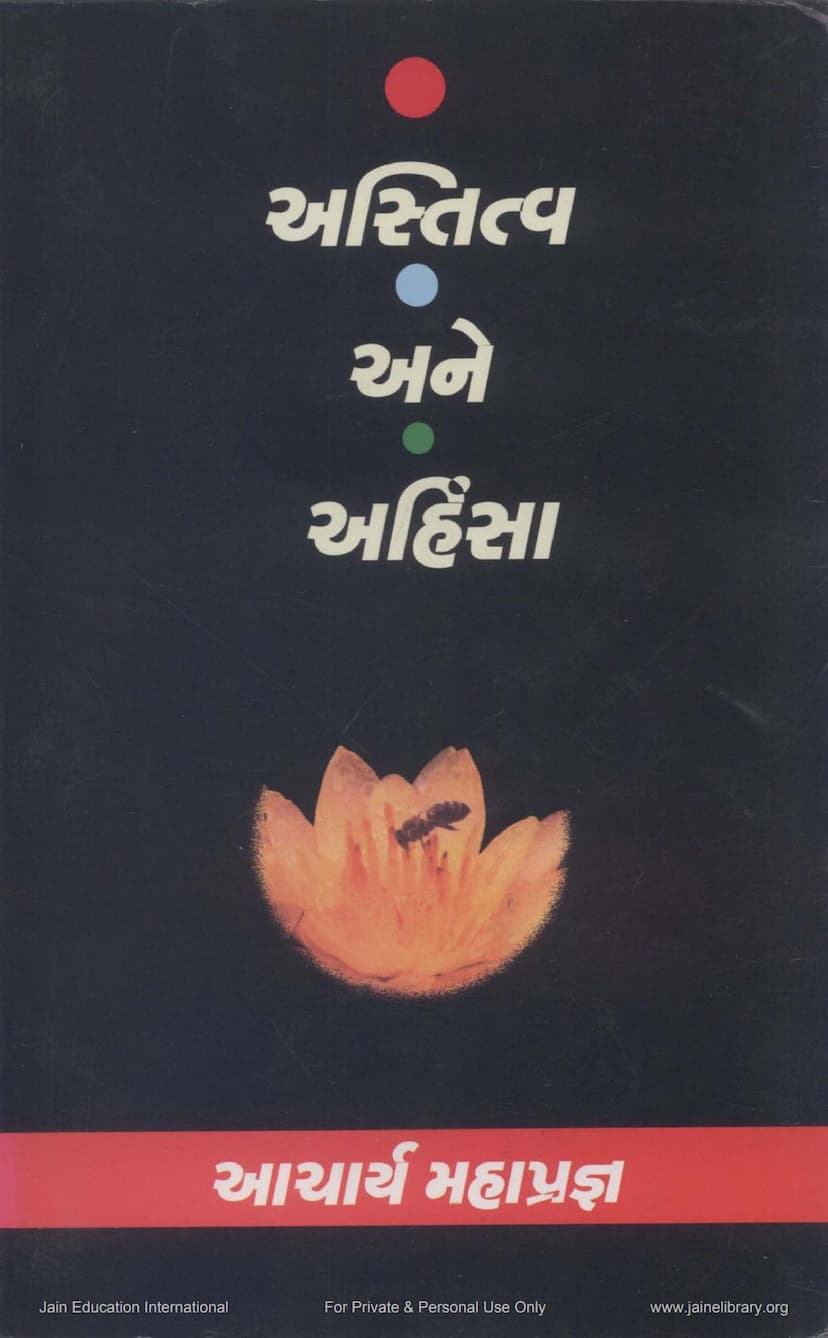Astittva Ane Ahimsa
Added to library: September 1, 2025

Summary
Here's a comprehensive summary of the Jain text "Astittva ane Ahimsa" (Existence and Non-violence) by Acharya Mahapragna and Rohit A Shah, based on the provided pages:
Book Title: Astittva ane Ahimsa (Existence and Non-violence) Author(s): Mahapragna Acharya, Rohit A Shah Publisher: Anekant Bharati Prakashan Core Theme: The book deeply explores the interconnectedness of existence and non-violence within the framework of Jain philosophy. It argues that true understanding of non-violence stems from a profound realization of the nature of existence itself.
Key Concepts and Arguments:
-
Existence as a Universal Truth: The book posits that "that which is, is existence." Existence is not dependent on our acceptance or rejection; it simply is. It is eternal, continuing from the past, present, and into the future. Existence is in a constant state of transformation, never ceasing to be. This makes existence eternal and indestructible, much like the soul, which transcends birth and death. Even physical objects like a book may perish, but the existence of their constituent atoms remains.
-
Violence as Death: The text strongly equates violence with death. Anything that is born will eventually die. Conversely, that which is never born cannot die. The implication is that harming any entity is a form of violence that disrupts its existence, leading to a form of death.
-
The Connection Between Violence and Existence: A central question explored is whether violence is intrinsically linked to existence. If violence occurs, does existence cease? The book delves into the relationship between non-violence and existence, seeking the connecting bridge between them.
-
The Superficiality of Personality vs. The Depth of Existence: We have an existence, but we often lack the experience of that existence. We get entangled in our "personality" (vyaktitva), which is merely an expression of our underlying existence. Our existence manifests in various forms – human, animal, plant, earth, water, fire, air. While existence is equal, personalities are not. Existence is unseen, while personality is visible. Existence is pure, while personality is mixed with impurities. Personality perishes; existence does not. Personality can be destroyed; existence cannot.
-
Mahavira's Philosophy of Non-violence: The core of Mahavira's teachings is that killing a person is violence tied to the physical body. Harming someone mentally through ill thoughts is mental violence. Pressuring one person to uplift another is emotional violence. You can harm an individual, but not their existence. You can bring someone down, but not their existence. The fundamental truth is that one can be killed but not eradicated. The rise and fall of a personality are not within anyone's control.
-
Non-violence is Based on Existence: The basis of non-violence is existence itself. Since existence does not perish or get destroyed, one should not harm or degrade others. Personality, being impermanent and ever-changing, cannot be the basis of non-violence.
-
The Concept of Six Life-Entities (Shat Jivan Kayas): The book highlights a unique Jain principle of the six categories of life-entities: earth-bodied (prithvikaya), water-bodied (apkay), fire-bodied (tejukaya), air-bodied (vaukay), vegetation-bodied (vanaspatikaya), and mobile-bodied (trasakaya). Mahavira's profound insight was not just that these elements contain life, but that they are life-forms themselves. This detailed classification demonstrates an incredibly subtle understanding of existence, even down to the most minute forms of life, which other philosophies have not reached with such specificity. This concept is presented as evidence of Mahavira's omniscience.
-
Reconciling Ancient Wisdom with Modern Science: The text emphasizes that the principles laid down by Mahavira thousands of years ago, particularly concerning non-violence and the subtle nature of life, resonate with modern scientific findings. Concepts like the interconnectedness of living beings and the potential sentience of plants are discussed, showing the enduring relevance of Jain teachings.
-
The Problem of Unsustainable Consumption: The book links modern environmental crises, like pollution and the depletion of resources, to human insatiability and lack of restraint (asamyam). Excessive desire and consumption lead to unnecessary violence. Jainism's emphasis on minimizing harm, even accepting unavoidable violence with regret, is presented as a path to curbing unnecessary harm.
-
The Importance of Self-Control (Sanyam): The core of non-violence is presented as self-control. Without self-control, one cannot truly understand or practice non-violence. Self-control is equated with non-violence, and lack of self-control with violence.
-
The Role of Intent and Thought: The text discusses mental violence (harmful thoughts) and emotional violence (suppressing one to uplift another) as integral parts of Mahavira's understanding of violence, alongside physical harm.
-
The Critique of Materialism and the Call for Inner Realization: The book implicitly criticizes a purely materialistic worldview that focuses only on visible phenomena. It encourages a journey from the personality (vyaktitva) towards the realization of true existence (astitva). This inner journey leads to the development of non-violence, self-control, and equanimity.
-
The Interdependence of Concepts: The book demonstrates how concepts like non-violence, purity, equanimity, and self-control are not isolated but are interconnected aspects of a larger spiritual path.
-
The Significance of Inner Transformation: The emphasis is on inner transformation, moving beyond external actions to the root causes of behavior. The goal is to cultivate qualities that naturally lead to ethical conduct.
Overall Message:
"Astittva ane Ahimsa" is a profound philosophical and spiritual exploration that bridges ancient Jain wisdom with contemporary concerns about existence, ethics, and the environment. It argues that a deep understanding and practice of non-violence are intrinsically linked to recognizing the pervasive nature of existence and cultivating inner restraint, equanimity, and self-awareness. The book aims to inspire readers to embark on a journey of self-discovery, moving from the superficialities of personality to the profound depths of their true existence, guided by the principles of non-violence and self-control.